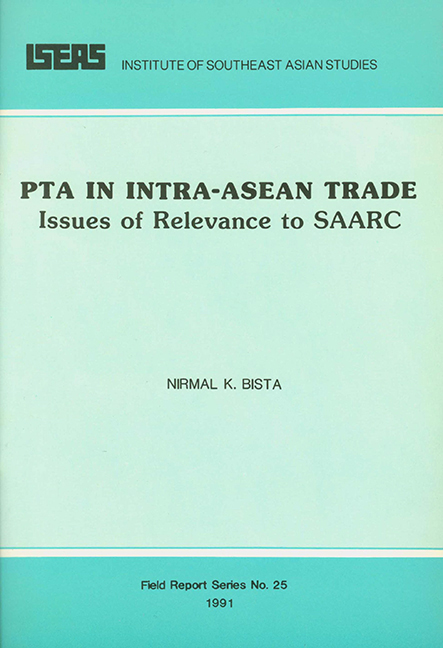III - ASEAN Preferential Trading Arrangements
Published online by Cambridge University Press: 21 October 2015
Summary
An Overview
The ASEAN Preferential Trading Arrangements (PTA) were introduced in 1979 in order to move towards regional growth through an increase in intra-regional trade and investments. The PTA aimed at gradual harmonization in policies regarding trade development, moving towards economies of scale and efficient factors allocation.
Following the Bangkok Declaration of 8 August 1967 (also called the ASEAN Declaration), a later Bali Summit (1976) modified ASEAN's strategy by adopting a two-pronged approach for co-operation. The modification of strategy was felt necessary in view of non-attainment of tangible economic achievements. Subsequently two documents were signed: (a) the Declaration of ASEAN Concord and (b) the Treaty of Amity and Co-operation in Southeast Asia. Both documents underlined the need for co-operation in various fields including basic commodities, industry, trade, a common approach on international trade issues, etc.” The Bali Summit recognized that co-operation in trade could promote development and growth and the PTA specifically were identified as a vehicle to move towards this direction.
ASEAN PTA signed on 24 February 1977 came into force on 1 January 1978. It was envisaged to encompass the following:
1. long-term quantity contracts;
2. purchase finance support at preferential interest rates;
3. preference in procurement by government entities;
4. extension of tariff preferences;
5. liberalization of non-tariff measures on a preferential basis; and
6. others
The goods seeking preferential treatment under PTA is to comply with content requirements under “the origin criteria”, “the consignment conditions” and “the documentary requirement”. The origin criteria were aimed at confining benefits to the goods produced or manufactured in ASEAN member countries. The ASEAN tariff “margin of preference” (MOP) is based on “item-by-item” concessions offered voluntarily by individual countries. The margin ranged from 10 to 50 per cent and has already covered about 14,000 items.
- Type
- Chapter
- Information
- PTA in Intra-ASEAN TradeIssues of Relevance to SAARC, pp. 13 - 16Publisher: ISEAS–Yusof Ishak InstitutePrint publication year: 1991



